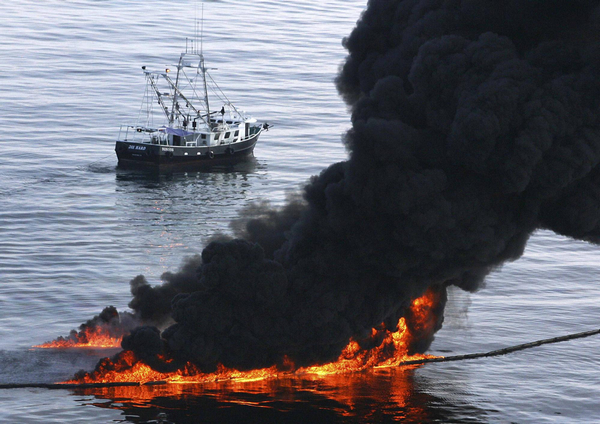-
News >World
BP sues rig owner for $40B on spill anniversary
2011-04-21 10:47
Smoke billows from a controlled burn of spilled oil off the Louisiana coast in the Gulf of Mexico coast line in this June 13, 2010 file photo. April 20, 2011 is the first anniversary of the Deepwater Horizon rig explosion at BP's Macondo undersea well in the Gulf of Mexico. The accident killed 11 workers and triggered the United States' worst offshore oil spill, which was also the biggest ever accidental release of oil into an ocean. [Photo/Agencies]NEW ORLEANS - BP on Wednesday sued the maker of the device that failed to stop last year's calamitous Gulf oil spill and the owner of the rig that exploded, alleging that negligence by both helped cause the disaster.
The British company said in papers filed in federal court in New Orleans that it is suing rig owner Transocean for at least $40 billion in damages, accusing it of causing last year's deadly blowout in the Gulf of Mexico that led to the worst offshore oil spill in US history. BP says every single safety system and device and well control procedure on the Deepwater Horizon rig failed.
It also is suing Cameron International, which provided a blowout preventer with a faulty design, which caused an unreasonable amount of risk that harm would occur.The lawsuits, filed on the first anniversary of the explosion that led to the spill, seeks damages to help BP pay for the tens of billions of dollars in liabilities it has incurred from the disaster.
Though BP has estimated its liabilities at $40.9 billion, it still could face tens of billions of dollars more in civil and criminal fines and penalties from the US government.
"The Deepwater Horizon BOP was unreasonably dangerous, and has caused and continues to cause harm, loss, injuries, and damages to BP (and others) stemming from the blowout of Macondo well, the resulting explosion and fire onboard the Deepwater Horizon, the efforts to regain control of the Macondo well, and the oil spill that ensued before control of the Macondo well could be regained," BP said in the lawsuit against Cameron.
BP wants the court to award the oil giant damages against Cameron and to declare that the device maker caused or contributed to the disaster and is responsible for some or all costs incurred by BP.
Eleven people were killed when the Deepwater Horizon rig exploded on April 20, 2010, leading to more than 200 million gallons (757 million liters) of oil spewing from an undersea well.
A testing firm hired by the government determined last month the blowout preventer had a faulty design. But it also cited other problems related to rig crew actions.
BP said in a statement that it wants Transocean to pay its "proportionate" share of all damages and liabilities from the disaster. A Transocean spokesman did not immediately respond to an email seeking comment.
Houston-based Cameron noted in a statement emailed to AP that Wednesday was the deadline under the relevant statute for all parties to file claims against each other.
"It is not surprising that the companies are filing to protect their indemnity rights (except in the case of BP) and whatever claims they believe they have," Cameron said. "Additionally, in order to protect ourselves, we, too, have filed crossclaims and counterclaims, including our indemnity claims, against other parties to the litigation."
Cameron, one of the largest makers of blowout preventers, has defended the integrity of its devices and workmanship.
Also Wednesday, Transocean filed court papers demanding that judgments be made against BP, Cameron and other companies in its favor. Among other things, Transocean wants a judgment against BP for $12.9 million and a judgment against cement contractor Halliburton and other companies for $20 million.
Transocean said the figures stem from contractual obligations and the money it lost when the rig sank.
